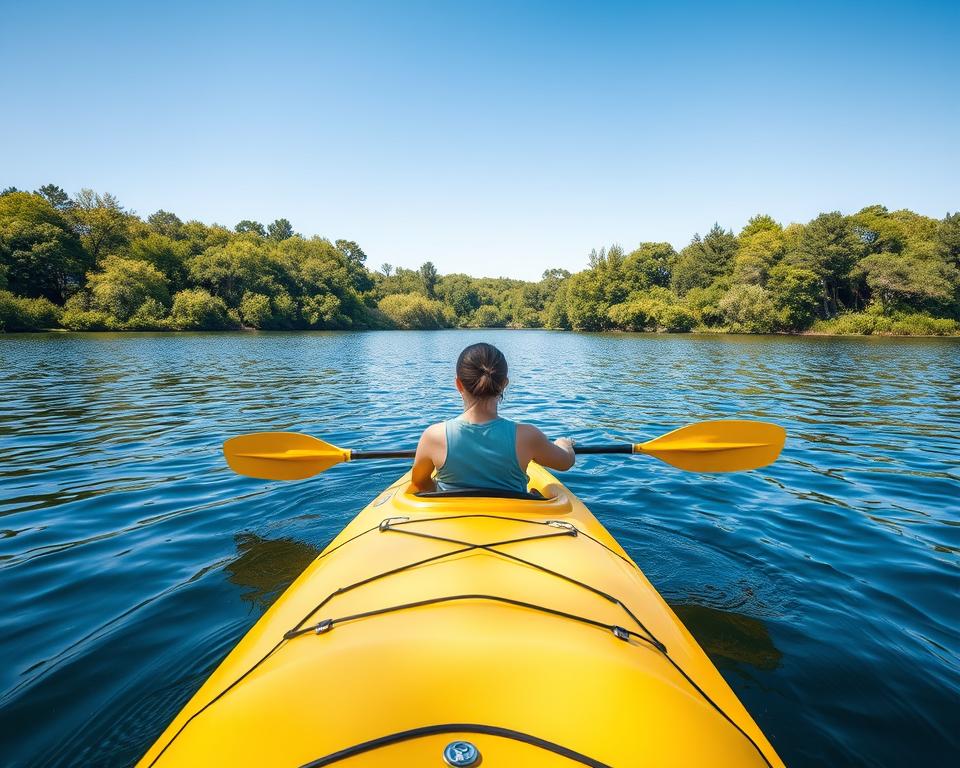Welcome, fellow paddler! If you’re new to kayaking, it’s key to learn basic kayak paddling techniques. Knowing how to paddle right saves energy and boosts your fun on the water. Let’s go over the beginning steps of kayaking.
Stacey Johnson from Outdoorplay offers great tips for mastering kayaking. First, how you hold your paddle is crucial. A right angle in your arms and a soft grip make all the difference between fun and fatigue.
Make sure your paddle blades face the water straight, and grip it from above. These tips lay the groundwork for learning advanced moves. Like the forward stroke, reverse stroke, sweep stroke, and draw stroke.
Next, we’ll dive deeper into these advanced techniques. We’ll see how they help save effort and make paddling more effective. But let’s start with the basics. Kayaking might seem easy, but doing it well takes more than simple paddling. Keep an eye out for our full guide to up your kayaking game!
Why Learning To Paddle Correctly Is Important
Learning to paddle a kayak right is key to saving energy and having fun in the water. Mastering the right technique makes paddling smoother. It also makes your strokes more efficient.
Benefits of Proper Technique
Paddling the right way helps you save energy. This is crucial when you’re on the water for a long time. It lets you last longer with less effort.
Using your torso and core, not just your arms, makes a big difference. It boosts your staying power and makes moving through water easier. Stacey Johnson talks about keeping a firm but relaxed grip for the best performance.
Understanding Energy Efficiency
Knowing about energy efficiency in paddling means mastering the right grips and orientations. The type of kayak paddle blades makes a difference in how efficient your strokes are.
Correctly holding and orienting the paddle boosts your stroke effectiveness. This deep understanding helps save energy and ensures each stroke moves you smoothly through the water.
Getting Comfortable With Water
Many hesitate to try kayaking due to fear of water. This is true for over 70% of non-swimmers who feel uneasy in deep water. Overcoming this fear is key for enjoying kayaking, making water safety feel natural.
Overcoming Fear of Water
The anxiety of deep water is familiar to many. Knowing you’re not alone helps. A 5-day canoe trip, for example, can boost your confidence. Tackling fear in a safe setting helps lessen it. Sharon Brodin believes local swimming lessons significantly help conquer aquaphobia. Once comfortable with water, kayaking turns more fun and less scary.
Starting kayaking on calm, flatwater, like a small lake, is wise. It’s crucial for skill-building and gaining water comfort. Learning to get in and out of a kayak is essential for safety and confidence.
A guide on getting comfortable in a kayak is available here. Tweaking your setup for personal comfort can make a huge difference.
The Importance of Swimming Skills & PFDs
Swimming is crucial for kayakers, acting as a safety net. Being a good swimmer makes you feel secure, boosting enjoyment. Always wear a Personal Flotation Device (PFD) for safety. It greatly increases survival chances during mishaps.
Right gear and apparel also enhance kayaking. For newcomers, learning to swim well and focusing on water safety lays a strong safety foundation.
Engaging in kayaking for fun has reduced anxiety by 60% in participants. Each kayaking journey is personal. Overcoming water fears and valuing swimming skills enriches your paddling experience.
Choosing the Right Kayak and Equipment
When picking a kayak, think about what you’ll use it for, the water you’ll be in, and your size. The market has lots of options, but knowing what you need helps you choose.
Types of Kayaks: Inflatable vs. Hardshell
You’ll have to decide between inflatable and hardshell kayaks first. Inflatables are light, easy to carry, and great if you don’t have much room. They work well in many water conditions, but hardshells last longer.
Hardshell kayaks are more durable and perform better. Sit-on-top models are good for warm places and kids. Sit-inside kayaks are best for cold water and quick paddling. Always try a kayak before you buy it to make sure it fits your needs.
Essential Gear: Paddles, Life Jackets, and More
The right gear is crucial for kayaking. Choose paddles that match your height and kayak type. Brooklyn Kayak Company suggests adjustable paddles for a better fit and easier paddling. Light materials like fiberglass make paddling less tiring.
Life jackets, or PFDs, are key for your safety. They should fit well and be comfortable. Dry bags are a must to keep your stuff dry and safe while on your journey.
The Role of Dry Bags and Proper Attire
Kayaking clothes are important for your comfort and safety on the water. Depending on the water’s temperature and the weather, you might need different wetsuits, rash guards, or jackets. High-quality, waterproof dry bags will keep your clothes and essentials dry.
Wearing the right clothes can greatly improve your time kayaking. Remember, the correct gear makes a big difference when you’re on the water.
What Snacks Should I Bring on a Long Hiking Trip for Energy While Learning How to Paddle a Kayak?
When planning a long hiking trip, consider snacks that boost energy for hiking adventures, such as trail mix packed with nuts, seeds, and dried fruit. Energy bars and jerky are also excellent choices, providing protein and healthy fats. These delicious options will keep you fueled while learning to paddle a kayak.
How To Hold a Kayak Paddle
Mastering the right way to hold a kayak paddle is a must for new kayakers. It’s surprising but true – knowing how to grip and orient the paddle impacts how well you move and enjoy the water. Let’s learn the basics to ensure you’re paddling correctly from the start.
Gripping Your Paddle Correctly
The key to a good paddle grip is the ‘paddler’s box.’ This box shape happens when you hold your paddle with hands about 40 centimeters apart. Your hands should also be around 30 centimeters from your body. This grip should feel strong, yet comfortable.
Ensure your knuckles are in line with the blade for the best control. Both right-handers and left-handers have to adjust this grip to fit them. Remember, your grip should be firm but not too tight. You shouldn’t see your knuckles turn white. A softer grip avoids strain and helps you paddle stronger.
Orienting Your Paddle
New kayakers often hold their paddle backwards at first. Remember, paddles have two blades that are not the same on both sides. You should align the bigger side of each blade with the top. For paddles with angled blades, the right blade usually angles up for better movement.
Changing the blade angle, which can be from 15 to 60 degrees, improves how well you paddle. Getting this right makes a big difference in your paddling.
Understanding Paddle Types
Kayak paddles vary to match your paddling style. Some paddles are adjustable, letting you change the blade angle. Others are simpler without adjustable features. Knowing which paddle suits your need is key.
As Bethany Cartner suggests, learning different strokes like the reverse, sweep, and draw strokes is vital. Start in calm water to practice. It’s good to use a paddle that helps you control your kayak easily. And always use your torso to paddle, not just your arms, to avoid getting tired too quickly, as Paddling.com advises.

